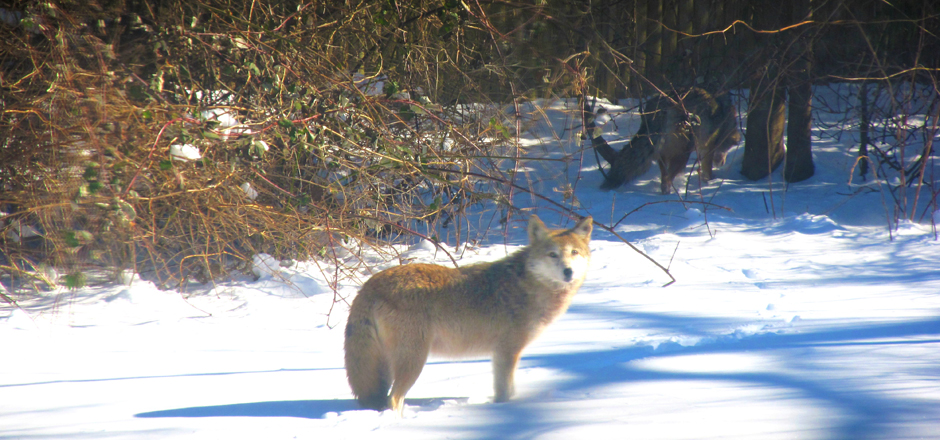Recent coyote sightings on Aquidneck Island or Jamestown?
Click right to report.
GUIDELINES to follow when you see a coyote…
…crossing a yard or street
Coyotes are most frequently seen and heard during mating season (January-March) and when juveniles start leaving the family pack (September-November). While normally fearful of people, they can sometimes be spotted crossing yards or streets. This behavior is not unusual, especially in residential areas bordering on open space where coyotes find their natural prey. They may simply be taking a shortcut to their favorite hunting ground. This type of sighting generally requires no response—other than making sure that pets and children are secure and that there are no likely food attractants (see Easy Pickin’s) present in the area.
…lounging in a yard or approaching/following people
Coyotes are naturally timid animals and will usually flee at the sight of a human. If they linger or approach, it’s time to begin “hazing.” This is a term applied to the following actions that can be taken to scare coyotes and chase them away:
- Be as big and loud as possible. Do not run or turn your back.
- Wave your arms, clap your hands, and shout in an authoritative voice.
- Make noise by banging pots and pans or using an air horn or whistle. These sounds can also alert the neighbors.
- Throw small stones, sticks, tennis balls or anything else you can lay your hands on. Remember the intent is to scare and not to injure.
- Spray with a hose, if available, or a squirt gun filled with water and vinegar.
- Shake or throw a “coyote shaker”—a soda can filled with pennies or pebbles and sealed with duct tape.
The effects of hazing may not last unless all food attractants are permanently removed. This information should be shared with neighbors, friends and homeowner’s associations since hazing is most effective when the entire neighborhood is working together.
Hazing should never be attempted if the coyote is accompanied by pups or appears to be sick or injured. If it’s the latter, make a report to the local police or the RI Division of Fish and Wildlife at 401-789-0281.
…failing to respond to hazing
Some coyotes may freeze and stare, or run a short distance and stop. Hazing should be continued until the coyote gets the message and finally leaves the scene. Hazing can work whether the encounter is with a lone coyote or a small pack. If the leader retreats, the rest of the pack will follow. If the coyote refuses to retreat or returns to the area despite persistent hazing, it may be due to the fact that someone is feeding coyotes nearby. This is a cause for concern and should be reported to the local police or animal control officer.
…approaching a pet or a child
Small pets and children should never be left unattended, and dogs should always be walked on a leash. Problems are more likely to occur when the animal is out of the owner’s control. It can also be helpful to carry a noisemaker, squirt gun or pepper spray. If a coyote approaches, pick up the pet or child, then start hazing. If the coyote does not leave, back away slowly while continuing to haze and go indoors if possible. Any aggressive behavior should be reported to the local police or animal control officer. If bites or other injuries are sustained, medical attention should be sought and a report made to the RI Division of Fish and Wildlife at 401-789-0281.
To view our VIDEO on What to do if you see a coyote, click here.
Photo credit: ©Ken Yellis, Newport, RI. Coyote spotted in a Newport yard; mate partially visible in shrubs.


